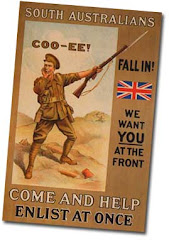 Harry Heyer was a son of William Heyer and Mary Ann Heyer (nee Zachariah) who lived at 'Haldeen' a property on Waverley Ridge between Upper Sturt and Crafers. He was born at Upper Sturt in 1892 and grew up in the district, working for the South Australian Railways as an engine cleaner.
Harry Heyer was a son of William Heyer and Mary Ann Heyer (nee Zachariah) who lived at 'Haldeen' a property on Waverley Ridge between Upper Sturt and Crafers. He was born at Upper Sturt in 1892 and grew up in the district, working for the South Australian Railways as an engine cleaner.He enlisted on 24 September 1915 at the age of 23 at which time he was working and living in Murray Bridge. After undergoing signalling training at Mitcham Camp, he was eventually allocated to the signals section of the headquarters of the 43rd Battalion, the third battalion to be raised solely in South Australia. He may have had trouble enlisting earlier in the war as he was only 5'4" tall, and this was under the minimum height imposed at the start of the war. As casualties mounted, the military authorities reduced the height requirements. The 43rd Battalion embarked from Adelaide on the transport 'Afric' on 9 June 1916, and disembarked at Marseilles in the south of France on 20 July 1916 after a short stop in Egypt. After entraining for the Channel coast and further training in England, the battalion was sent to France in late November 1916, and arrived on the Western Front the following month.
After an initial stint in the so-called 'nursery sector' near Armentieries, the battalion was rested in April 1917 at Oosthove Farm, during which Harry was sent for three days further signals training. In late April they returned to the mud-clogged frontline near Ploegsteert, and conducted several raids into the enemy trenches opposite. In June 1917, the 43rd Battalion was initially in a reserve role during the Battle of Messines, but then took over the advance as resistance stiffened, resulting in 143 casualties suffered by the battalion between 2-12 June.
After a short stint back in reserve, the battalion re-entered the frontline north-west of Warneton in late June 1917. On 1 July 1917, Harry was working at battalion headquarters when the area was heavily shelled by the Germans resulting in several casualties. Harry was hit in the back and left shoulder, and was evacuated via the 9th Field Ambulance and the 11th Casualty Clearing Station, but died of his wounds later that day.
He was buried in the Bailleul Communal Cemetery Extension, France. His mates from the signals section erected a cross over his grave.
Harry's younger brother William served in the 32nd Battalion and was killed in France on 29 September 1918.
Harry's name is inscribed on honour rolls in the Upper Sturt Methodist Church, Upper Sturt Memorial Hall and Adelaide Railway Station and on the Aldgate Memorial.
Photograph: Courtesy State Records of South Australia



